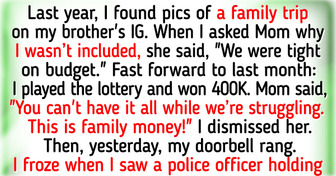21 Things Parents and Children Learned When They Stopped Living Under the Same Roof

We may be a diverse planet, and yet, all humans are 99.9% the same, genetically. The diversity in looks comes from that 0.1% of the difference in genes. Called alleles, these genes ensure we look like our families. While children are not carbon copies of their parents, their features match. And yet, sometimes, the opposite happens.
Bright Side got into the whys and hows of reported instances where babies looked way different from their parents. And the reasons flummox the medical community as well.
Our genes determine the eye, skin, and hair color along with other inane details. Like innie or outie belly buttons, curly or straight hair, a hitchhiker’s thumb or a curved one, and joined or separated earlobes, these genes determine our height and our predisposition to diseases, and they basically map out our future.
But sometimes, genes skip a beat, miss generations, or suddenly evolve to head off into a different direction. For instance, human beings lost the ability to make vitamin C in their bodies. This led to a mass change in human evolution.
And there are other times when you can see genetics at play, literally, when babies decided to look absolutely different from their parents. Geneticists, researchers, and other experts primarily give 3 reasons for this.
Sometimes, genes undergo a mutation. They change for no reason at all and can give rise to a whole new set of features in the coming generations — or not. This means they can appear in one generation and disappear in the next.
We do know of some genetic mutations, like distichiasis, which results in unusually thick eyelashes. Then there’s heterochromia, as in different colored eyes. Sometimes, similar mutations in genes that determine skin color can cause fair-skinned babies to be born to a darker-skinned couple. Or vice versa.
When it comes to offspring, it’s the same set of genes, but it’s how the combination is made that goes on to decide how a child will look. A person’s skin color is the result of a combination of pigmentation from 11 different genes that basically control the amount of melanin produced in the skin.
There are 2 types of melanin as well, eumelanin and pheomelanin. Genes dictate if your skin will have more eumelanin, which will create darker skin, or more pheomelanin. The latter makes for lighter skin with freckles.
If a light-skinned baby is born to darker-skinned parents, doctors theorize that the parents could be carrying light-skinned genes. These genes could be dormant in both the parents but come to the foreground in the baby. The opposite has also been seen because, sometimes, dark-skinned babies are born to fair-skinned Caucasian couples. Sometimes genes just decide to wake up and other times, go dormant. The scientific community is still trying to understand what causes these changes in the first place.
Albinism could be another cause behind the obvious skin color difference between a child and the parents. In albinism, the skin does not make as much melanin as the ethnicity demands, genetically.
The albinism could be partial, leaving the skin in patches, or it could be complete, making for a very pale-skinned child, even if the parents are dark-skinned and come from other ethnicities. In several African countries, people with albinism are subject to superstitions and, sadly, sometimes rejected by their own families.
Sometimes, it’s simply about paternity — or maternity. Darker-skinned women can and do bear light-skinned children if the father is light-skinned and vice versa. Like in the case of Zendaya, whose father is of African-American descent, while her mother is of mixed European heritage. If paternity and maternity are known, it’s no surprise.
But in cases where the paternity is not known, sometimes there are IVF mix-ups. A black couple undergoing IVF may ask for a donor from African heritage, but errors do happen, leading to a fair-skinned child of different ethnicity.
A very obvious and very sweet reason is adoption. Take for instance the multi-ethnic family of Angelina Jolie and her children, whom she shares with her ex, Brad Pitt. There’s Maddox, who was adopted from Cambodia, and Zahara, who was adopted from Ethiopia. Jolie and Pitt had their first biological child, Shiloh, in 2006, and then they adopted Pax from Vietnam. Finally, their twins, Vivienne and Knox, were born in 2008.
When Ben and Angela Ihegboro went to the hospital for the birth of their daughter, Nmachi, it turned out to be a surprise. The couple is Nigerian, of African ethnicity, but their daughter was pale, as white as a Caucasian person, with blonde hair and blue eyes.
Doctors reasoned out all 3 possibilities in this case. Her fair skin and blue eyes could be because of a kind of albinism, recessive genes, or even an unknown genetic mutation. Thankfully, Nmachi’s parents declared that they would love her just as much as their other darker-skinned children.
Do you have any such unique features in your family? How did medical science explain these distinctions to you?
Got some cool photos or stories and want to be featured on Bright Side? Send them all right HERE and right now. Meanwhile, we’re waiting!











